Not too long ago, at our local Larurel’s Prize Tourney (I have picture of that coming soon), I was approached and asked to design a charter for a new children’s A&S award. For those of you unfamiliar, a charter is a scroll that has spaces left blank for the recipient’s name, the date, royal signatures, etc. They also usually have linework designs on them, so each can be painted individually. I’ve never made a charter design before, and I was thrilled to be asked. It turns out that charter-designing is pretty different from one-off scroll-design.
First, I needed some inspiration. It was a tough decision, actually. I needed a design (a later period design, at the request of Their Majesties) that was complex enough to stand on its own if a very beginning painter just used flat colors, and something that would give more advanced painters the chance to go to town with shading if they wanted to. In the end I went with Francesco Marmitta’s Rangoni Bentivoglio Book of Hours, an Italian work from around 1500. It’s currently housed at the Walters Art Museum in Baltimore.
Not shown: taking ideas from several leaves of the Book and sketching them out on graph paper to get the proportions right within my space limitation. I then brought the images into photoshop to get everything the way I wanted and mirrored without a whole ton of problems. Then I traced the image onto tracing paper so I could easily transfer it to the final working paper.
I knew I wanted to make sure the hand was consistent with the illumination style, so I went through all the pages I had and pulled out several letters that appeared on them. To fill in the gaps, I looked through Stan Knight’s amazing book Historical Scripts from Classical Times to the Renaissnce for similar times and places.
I did a couple of calligraphy drafts…
And then a couple more. The problem with creating a charter is that you have to leave space enough for a hugely long name (because someone might have picked Tangwystyl Fairehayvenn of Llanleystocke as a name, rather than John York), a hugely long area of expertise (again, calligraphy and illumination, as opposed to gaming) and placename. Trying to make sure that each of those had enough space, as well as the date, years, and signatures was difficult. I went through six different drafts, instead of my normal two or three. At least it gave me the time to practice my hand?
I use a small lightbox (9×13 or so) to stransfer small scrolls like this one. For larger scrolls, I tape the paper to my french doors. Thank goodness for th Texas sun. A friend of mine is actually going to make me a bigger light table, large enough to do peerage-sized scrolls. He made his wife one, and I’m intensely jealous. I trace out all my linework with 5mm mechanical pencil, in 2H hardness. I like the darkness of the line; I can see it well enough to ink, but it’s still easy to erase after, and the 5mm makes a consistently fine line on the paper.
Incidentally, I’m using Fabriano hot press watercolor paper here. It’s smooth and delicious to write and draw on, the ink I’m using (Scribal Arts Iron Gall ink for calligraphy, Platinum carbon blank ink in a LAMY fountain pen with extra-fine nib for the artwork) doesn’t bleed or feather, and it holds up to abuse (lots of wet paint, and scraping and burnishing for corrections) well.
Here you can see the pencils are all finished, and I’ve calligraphed the charter text. I’ll go back in later and fill in the premiere recipient’s information later.
Nearly finished inking. I’ve tried to reduce the lovely design into linework that evokes the delicate nature of the original without being too intimidating to paint.
And the charter is finished. At this point, I’ll wait for the ink to dry overnight to avoid any smearing of lines when I go back and erase the pencil guides. Then I’ll scan it into photoshop and correct any little tiny errors before printing out a nice bold master copy for our Star Signet (the scribe in charge of kingdom charters).
In the next installment, we’ll see how this goes from charter to finished award.

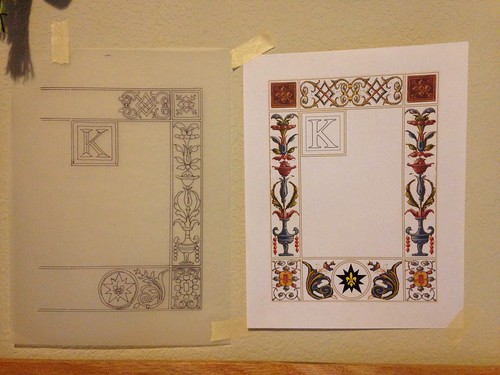
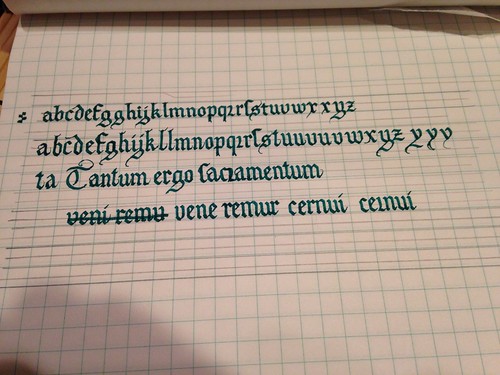
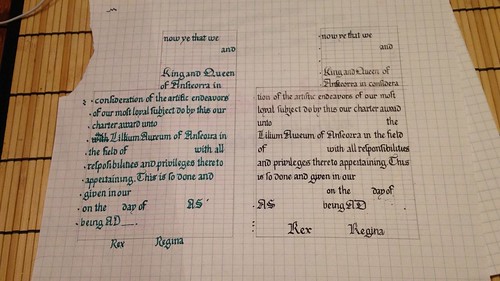
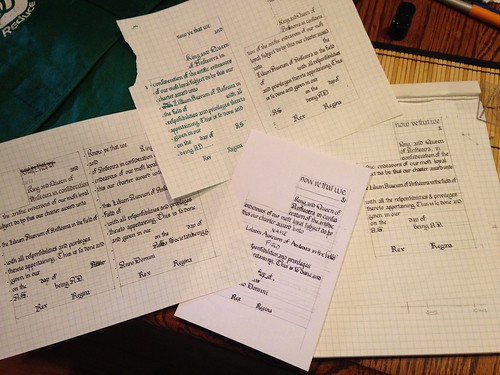
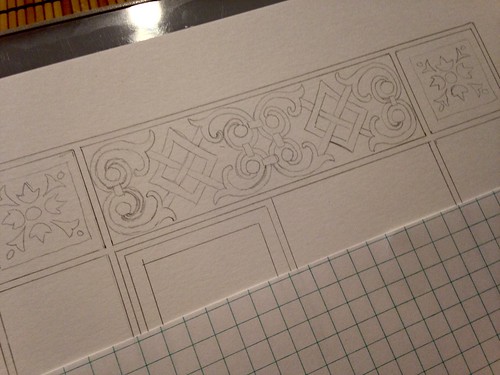
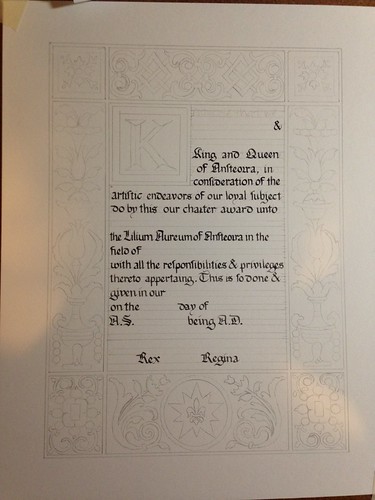


Excellent presentation! I look foward to the next installment
This is so beautiful and informative! Thank you.